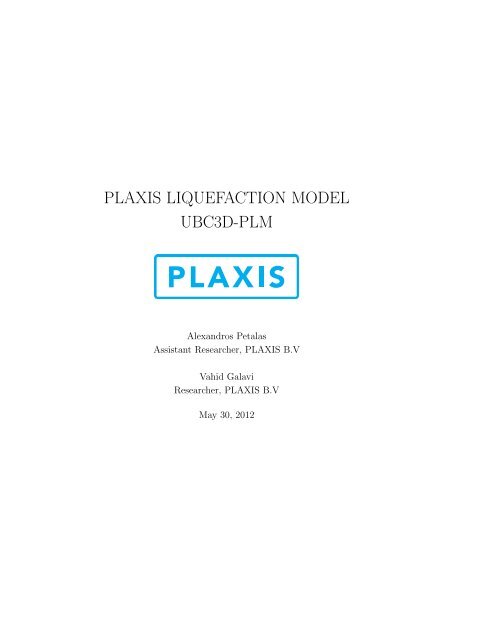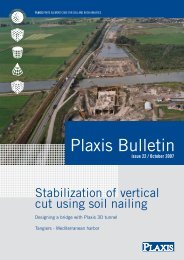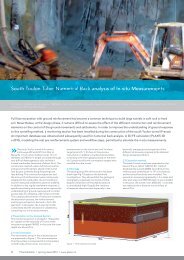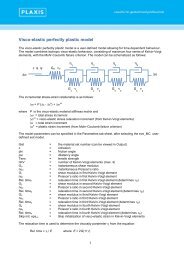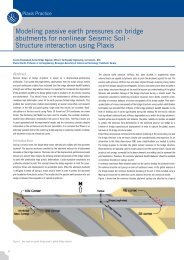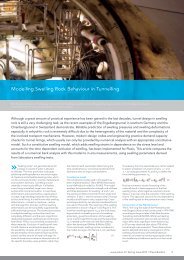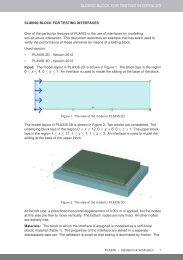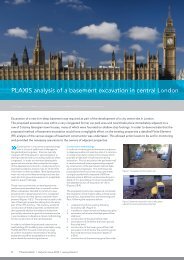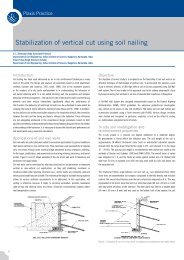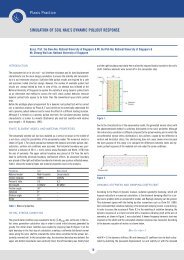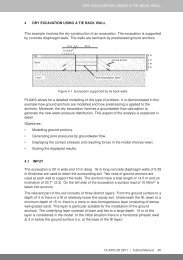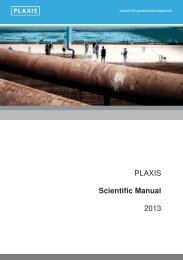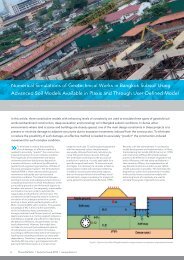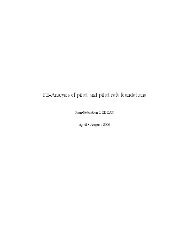PLAXIS LIQUEFACTION MODEL UBC3D-PLM - Knowledge Base
PLAXIS LIQUEFACTION MODEL UBC3D-PLM - Knowledge Base
PLAXIS LIQUEFACTION MODEL UBC3D-PLM - Knowledge Base
- No tags were found...
You also want an ePaper? Increase the reach of your titles
YUMPU automatically turns print PDFs into web optimized ePapers that Google loves.
<strong>PLAXIS</strong> <strong>LIQUEFACTION</strong> <strong>MODEL</strong><strong>UBC3D</strong>-<strong>PLM</strong>Alexandros PetalasAssistant Researcher, <strong>PLAXIS</strong> B.VVahid GalaviResearcher, <strong>PLAXIS</strong> B.VMay 30, 2012
List of Figures1.1 The intersection of the six planes and finally the yield surfacein 3-D principal stress space. From Tsegaye (2010) . . . . . . 41.2 Projection of the yield surface in the deviatoric plane . . . . . 51.3 Systematization of the yield surfaces in p’-q stress space . . . 61.4 The original UBCSAND’s Hardening Rule . . . . . . . . . . . 81.5 Graphical representation of the modified Rowe’s flow rule asused in <strong>UBC3D</strong>-<strong>PLM</strong> . . . . . . . . . . . . . . . . . . . . . . 101.6 Proposed reformulation of the <strong>UBC3D</strong>-<strong>PLM</strong> for cyclic loading 222.1 Validation of the <strong>UBC3D</strong>-<strong>PLM</strong> under monotonic triaxial compression.. . . . . . . . . . . . . . . . . . . . . . . . . . . . . . 242.2 Validation of the <strong>UBC3D</strong>-<strong>PLM</strong> under monotonic direct simpleshear. . . . . . . . . . . . . . . . . . . . . . . . . . . . . . 252.3 Validation of <strong>UBC3D</strong>-<strong>PLM</strong> in cyclic loading. Undrained behaviourof Fraser sand (RD = 40%) under cyclic simple shear.Stress path in Test 1 with CSR = 0.08. . . . . . . . . . . . . 272.4 Validation of <strong>UBC3D</strong>-<strong>PLM</strong> in cyclic loading. Evolution of theexcess pore pressure in Test 1. Fraser sand with RD = 40%.CSR = 0.08. . . . . . . . . . . . . . . . . . . . . . . . . . . . 282.5 Validation of <strong>UBC3D</strong>-<strong>PLM</strong> in cyclic loading. Stress-strainrelationship of Fraser sand with RD = 40% in Test 1. CSR =0.08. . . . . . . . . . . . . . . . . . . . . . . . . . . . . . . . . 293
3.6 Reproduced stress path in p ′ − q stress space during the numericalmodelling of the dynamic centrifuge. Stress point at13.8 m. . . . . . . . . . . . . . . . . . . . . . . . . . . . . . . 423.7 Reproduced stress path in a p ′ − q stress space during thenumerical modelling of the dynamic centrifuge. Stress pointat 24.8 m depth. . . . . . . . . . . . . . . . . . . . . . . . . . 423.8 Reproduced stress path in a p ′ − q stress space during thenumerical modelling of the dynamic centrifuge. Stress pointat 30.8 m depth. . . . . . . . . . . . . . . . . . . . . . . . . . 435
List of Tables1.1 Input Parameters for the <strong>UBC3D</strong>. . . . . . . . . . . . . . . . 191.2 State variables of the <strong>UBC3D</strong>. . . . . . . . . . . . . . . . . . 202.1 Model parameters used to simulate undrained behaviour ofloose Syncrude sand. . . . . . . . . . . . . . . . . . . . . . . . 232.2 Boundary values for simulating a cyclic simple shear test ina single stress point. . . . . . . . . . . . . . . . . . . . . . . . 262.3 Input parameters for modelling the undrained cyclic behaviourof loose Fraser sand. . . . . . . . . . . . . . . . . . . . . . . . 263.1 Input parameters for modelling the dynamic centrifuge. . . . 366
AbstractIn this report the formulation of the <strong>UBC3D</strong> constitutive model as implementedin <strong>PLAXIS</strong> is presented. The <strong>UBC3D</strong> is a 3-D generalized formulationof the original 2-D UBCSAND model introduced by Puebla et al. (1997).The initial 3-D implementation in <strong>PLAXIS</strong> was presented by Tsegaye (2010).An improved version is developed by the authors and the final model is presentedtogether with a validation in different monotonic and cyclic stresspaths. <strong>UBC3D</strong>-<strong>PLM</strong> consists a relatively simple but powerful approach inorder to model the onset of the liquefaction phenomenon. In Chapter 1the main features of the <strong>UBC3D</strong>-<strong>PLM</strong> are presented. The improvementsmade by the authors are also highlighted in order to distinguish the changesof the latest version. Briefly, the formulation of the plastic multiplier iscorrected and higher accuracy achieved for the monotonic case, a soil densificationrule was implemented and a second yield surface introduced inorder to ensure a smooth transition into the liquefied state and finally apost liquefaction factor introduced as an input parameter in order to modelthe post-liquefaction behaviour. The latter should be used for modelling elementtests leading to liquefaction of the soil, and extra attention is advisedduring modelling boundary value problems. In Chapter 2 the validationof the model in monotonic and cyclic stress paths is discussed. Finally, inChapter 3 the performance of the model in a finite element scheme is investigatedand the numerical modelling of a dynamic centrifuge test with<strong>PLAXIS</strong> 2D Dynamics is presented. The ability of the model to capturethe onset of liquefaction is thoroughly discussed. The capabilities and thelimitations are highlighted and recommendations for the use of the modelare summarized.
Chapter 1Key Features of <strong>UBC3D</strong>The <strong>UBC3D</strong>-<strong>PLM</strong> model has been developed by Tsegaye (2010) and implementedas a user-defined model in <strong>PLAXIS</strong>. It is closely based on theUBCSAND model introduced by Puebla et al. (1997), Beaty and Byrne(1998). The original UBCSAND is a 2-D model developed for prediction ofliquefaction in sandy soils. Its formulation is based on classical plasticitytheory with a hyperbolic strain hardening rule, based on the Duncan-Changapproach with modifications. The hardening rule relates the mobilized frictionangle to the plastic shear strain at a given stress. It contains a 2-DMohr-Coulomb yield surface and a corresponding non-associated plastic potentialfunction. The flow rule in the model is based on the stress-dilatancytheory developed by Rowe (1962), linearised and simplified according toenergy considerations.The main difference between the UBCSAND model and the <strong>UBC3D</strong>model is the latter generalized 3-D formulation. The <strong>UBC3D</strong> model uses theMohr-Coulomb yield condition in a 3-D principal stress space. Moreover, amodified non-associated plastic potential function based on Drucker-Prager’scriterion is used, in order to maintain the assumption of stress-strain coaxialityin the deviatoric plane for a stress path beginning from the isotropicline (Tsegaye, 2010).2
Comparing with the previous version of UCB3D implemented in <strong>PLAXIS</strong>,in the latest version a correction is made in the equation of the plastic multiplierwhich governs the constitutive relationship between the stresses andstrains and higher accuracy is succeeded during monotonic loading. Finally,a soil densification rule is added in order to predict a more realistic evolutionof excess pore pressures during cyclic loading. This allows the increase ofthe volumetric strains with a decreasing rate during shearing. Moreover,the bulk modulus of water is depended on the degree of saturation which isspecified via <strong>PLAXIS</strong> input and therewith this user defined model can beused in the Advanced calculation mode of <strong>PLAXIS</strong>.The main characteristics of the model as implemented by (Tsegaye, 2010)and modified by the authors are presented in the following sections.1.1 Yield SurfacesThe <strong>UBC3D</strong>-<strong>PLM</strong> model uses the well known Mohr-Coulomb yield functiongeneralized in 3-D principal stress space. In order to understand how thealgorithm deals with the complexity of the 3-D representation of the yieldsurfaces, the full set of the Mohr-Coulomb yield functions are introduced(pressure is positive, tension is positive):f 1a = 1 2 (σ′ 2 − σ ′ 3) + 1 2 (σ′ 2 + σ ′ 3) sin φ ′ − c ′ cos φ ′ (1.1)f 1b = 1 2 (σ′ 3 − σ ′ 2) + 1 2 (σ′ 3 + σ ′ 2) sin φ ′ − c ′ cos φ ′ (1.2)f 2a = 1 2 (σ′ 3 − σ ′ 1) + 1 2 (σ′ 3 + σ ′ 1) sin φ ′ − c ′ cos φ ′ (1.3)f 2b = 1 2 (σ′ 1 − σ ′ 3) + 1 2 (σ′ 1 + σ ′ 3) sin φ ′ − c ′ cos φ ′ (1.4)3
f 3a = 1 2 (σ′ 1 − σ ′ 2) + 1 2 (σ′ 1 + σ ′ 2) sin φ ′ − c ′ cos φ ′ (1.5)f 3b = 1 2 (σ′ 2 − σ 1) ′ + 1 2 (σ′ 2 + σ 1) ′ sin φ ′ − c ′ cos φ ′ (1.6)The six combinations of the principal stresses in the equations define sixplanes in 3-D principal stress space. These planes defines the Mohr-Coulombyield surface as presented in Figure 1.1. The projection of the yield surfacein the π -plane is presented in Figure 1.2.Figure 1.1: The intersection of the six planes and finally the yield surfacein 3-D principal stress space. After Tsegaye (2010).The first step that has to be done by the model is to compute the principalstresses of the stress tensor. This is done after solving the eigenvalueproblem. The eigenvalues give the principal stresses and the eigenvectorswill be their directions. As far as isotropic behaviour is concerned the directionsof the principal stresses are fixed (rotation of the principal stressesis not included in <strong>UBC3D</strong>-<strong>PLM</strong>) so the material response is not dependenton the orientation. After the determination of the three principal stresses4
Figure 1.2: Projection of the yield surface in the deviatoric plane. AfterTsegaye (2010).the yield surface has to be defined. Considering any stress path in the generalized3-D stress space visualized in the deviatoric plane, the yield surfacewhich will be first activated is given by the equation in which the maximumdifference between two principal stresses is being used. The critical yieldsurface in the model is given by Equation 1.7:f m = σ′ max − σ ′ min2( σ′− max + σ min′ )+ c ′ cot φ ′ p sin φ mob (1.7)2The above presented equation is derived by the Mohr-Coulomb failurecriterion using the maximum and the minimum principal stress as well asthe mobilized friction angle (see Section 1.2). In order to compute Equation1.7 the principal stresses are sorted as follows:− σ 1 ≥ −σ 2 ≥ −σ 3 (1.8)After the sorting and the development of the yield surface, three possiblestress paths can be produced by the model, in one of the six parts of theπ-plane; triaxial compression, triaxial extension and regular stress path, asdepicted in Figure 1.2.5
Referred to as the apex term, c cot φ p defines the point where the yieldsurface intersects the mean effective stress axis (p) (see Figure 1.3). Usually,in granular soils, the cohesion is zero, so the intersection would be locatedat the origin of the coordinate system (0,0).Figure 1.3: Systematization of the yield surfaces in p-q stress space. AfterTsegaye (2010).When the stress state is inside the space defined by the yield surfaceselastic behaviour is assumed. However, once the stress path touches theyield surface plasticity starts to occur. After the reformulation made bythe authors the latest version of the <strong>UBC3D</strong>-<strong>PLM</strong> has two yield surfaces inorder to distinguish between the primary and the secondary loading and toensure a smooth transition to the liquefied state. This mechanism is betterexplained in Section 1.5. The elasto-plastic behaviour of the model will beanalytically presented in the next paragraph.1.2 Elasto-plastic Behaviour and Hardening RuleThe elastic behaviour which occurs within the yield surface is governed by anon-linear rule. Two parameters control this non-linear behaviour; the elasticbulk modulus K and the elastic shear modulus G. These two moduli arestress dependent and the relationships are given in the following equations:6
( ) mepK = KBP e A (1.9)P ref( ) nepG = KGP e A (1.10)P refwhere KB e and Ke G are the bulk and the shear modulus respectively, at areference stress level. The factors ne and me are parameters define the rateof stress dependency of stiffness. In the literature, the reference stress level(p ref ) is commonly taken as the atmospheric pressure (P A =100 kPa). Pureelastic behaviour is predicted by the model during the unloading process.Once the stress state reaches the yield surface, plastic behaviour is predictedas long as the stress point is not going immediately back into theelastic zone. More specifically, plastic hardening based on the principalof strain hardening is used in the model. The hardening rule governs theamount of plastic strain (irrecoverable deformation) as a result of mobilizationof the shear strength (sin φ mob ). The mobilized friction angle derivedfrom the Mohr-Coulomb yield criterion (1.7) is given as:sin φ mob = σ′ 1 − σ′ 3σ ′ 1 + σ′ 3= t mobs ′ (1.11)where t mob is the mobilized shear stress and s is the mean effective stress(s).The hyperbolic hardening rule (Beaty and Byrne, 1998) is presentedschematically in Figure 1.4. It relates the increment of the sine of the mobilizedfriction angle to the plastic shear strain increment as follows (Pueblaet al., 1997):G ⋆ = k p Gδγ p =( 1G ⋆ )δ sin φ mob (1.12)( p′ ) np{ ( ) } 2sin φmob1 −R F (1.13)P A sin φ peak7
where k p Gis the plastic shear modulus number; np is the plastic shearmodulus exponent; φ mob is the mobilized friction angle, which is defined bythe stress ratio; φ peak is the peak friction angle; and R f is the failure ration f /n ult , ranging from 0.5 to 1.0, where n f is the stress ratio at failure andn ult is the asymptotic stress ratio from the best fit hyperbola.The hardening rule as reformulated by Tsegaye (2010) in <strong>UBC3D</strong>-<strong>PLM</strong>model is given as:Figure 1.4: The original UBCSAND’s Hardening Rule.Byrne (1998)From Beaty andd sin φ mob = 1.5K p G( ) (pnpp A1 − sin φ ) 2mobR f dλ (1.14)p A p m sinφ peakwhere dλ is the plastic strain increment multiplier.1.3 Plastic Potential FunctionThe plastic potential function specifies the direction of the plastic strain.A non-associated flow rule based on the Drucker-Prager plastic potentialfunction is used in the <strong>UBC3D</strong>-<strong>PLM</strong> (Tsegaye, 2010).8
The plastic potential function is formulated as:g = q − a ( p ′ + c cot φ p)(1.15)a =√3 sin ψmobcos θ +sin θ sin ψ√3(1.16)where θ is taken 30 ◦ to fit the Drucker-Prager surface in the compressionpoint.1.4 Flow RuleIn the <strong>UBC3D</strong>-<strong>PLM</strong> model the flow rule of the original UBCSAND modelis used, which is derived from energy considerations by Puebla et al. (1997).The flow rule used in UBCSAND is based on three observations: 1. thereis a unique stress ratio, defined by the constant volume friction angle φ cv ,for which plastic shear strains do not cause plastic volumetric strains; 2.stress ratios which lie below sin φ cv exhibit contractive behaviour, whilestress ratios above sin φ cv lead to a dilative response; and, 3. the amount ofcontraction or dilation depends on the difference between the current stressratio and the stress ratio at sin φ cv .The relationship is given as follows:dɛ p v = sin ψ m dγ p (1.17)sin ψ m = sin φ m − sin φ cv (1.18)where, dɛ p v is the plastic volumetric strain increment and φ cv is the constantvolume friction angle. A graphical representation of the flow rule isgive in Figure 1.5.9
Sine of the Mobilized Dilatancy Angle (º)sinψmob(max)-sinψmob(max)Dilative areasinφcvContractive areasinφpeakSine of the Mobilized Friction angle (º)Figure 1.5: Graphical representation of the modified Rowe’s flow rule asused in <strong>UBC3D</strong>-<strong>PLM</strong>.1.5 Cyclic Mobility and Stress Reversal<strong>Base</strong>d on the mobilized friction angle an unloading-reloading criterion isdefined in the model as follows:sin φ e m < sin φ 0 m(Unloading; elastic behaviour.) (1.19)sin φ e m > sin φ 0 m(Loading or reloading; plastic behaviour.) (1.20)The previous mobilized friction angle (sin φ o m) is memorized from theprevious calculation step, while the current one (sin φ e m) is calculated basedon the current stresses. During loading, the friction angle is mobilized, andhardening plasticity occurs. During unloading, pure elastic behaviour ispredicted until the stress point reaches the p ′ axis.A soil densification rule was introduced in the latest verion of the <strong>UBC3D</strong>-<strong>PLM</strong> in order to have higher accuracy in the predicted evolution of the excesspore pressures. A secondary yield surface was introduced in the model for10
the secondary loading in order to ensure a smooth transition into the liquefiedstate of the soil. This enables the distinction between primary andsecondary loading.The secondary yield surface generates less plastic strains compared to theprimary yield surface. An isotropic hardening rule is used for the primaryyield surface, while a simplified kimematic hardening rule is used for thesecondary surface. The plastic shear modulus K p Gduring primary loadingis identical with the one entered as input parameter by the user and is usedin the hardening rule governing the hardening of the primary yield surface.The plastic shear modulus K p Gduring the secondary loading is formulatedas a function of the number of cycles followed during the loading processin order to capture the effect of soil densification during drained shearingreported by many researchers in the literature (Martin et al., 1975).simple rule which defines the counting process of cycles is used. This leadsto an increase of the excess pore pressure during uncdrained cyclic loadingwith a decreasing rate until the liquefied state is approached.The densification rule is fully valid for symmetric loading cycles, for thecase that shearing starts from the isotropic stress state. In a p ′ − q stressspace when the mobilized friction angle is very small a half cycle is counted.The drained plastic shear modulus (K p G) becomes stiffer after the first fullcycle using Equation 1.24. This densification rule has been calibrated againstexperimental data for the behaviour of sands under cyclic simple shearing.(K p G = Kp G ∗ 4 + n )cross∗ hard ∗ fac hard (1.21)2where n cross is the number of half cycles generated from the beginning ofthe test, hard is a factor which is correcting the densification rule for loosesoils and fac hard is a multiplier which is a user input parameter to adjustthe densification rule.A correction is made in the densification rule for loose sands (5 ≤ N1 60 ≤9) according to the experimental observations and following the formulation11A
of the UBCSAND proposed by Beaty and Byrne (2011) and reported byNaesgaard (2011). The correction rule is as follows:hard = min(1, max(0.5, 0.1N1 60 ) (1.22)The plastic shear modulus is limited according to the maximum correctedSPT value (N1 60 ) of corresponding dense soils (Equation 1.23). Themaximum N1 60 for a very dense soil is defined as 60.K p G,max = Ke G ∗ (maxN1 2 60,max)0.003 + 100 (1.23)The new yield surfaces are schematically presented in Figure 1.6.InCase a, primary loading occurs during the first half cycle in an arbitrarysimple shear test starting from the p ′ axis. The initial input parameter forthe plastic shear modulus K p Gis used and both yield surfaces expand untilthe maximum stress state.In Case b, elastic unloading occurs and the secondary yield surfaceshrinks until it reaches the isotropic axis where sin φ mob is very small. Ahalf cycle is counted. Since an isotropic hardening rule is used for the primaryyield surface, it remains at the maximum stress state reached sincethe beginning of the test.In Case c secondary loading occurs but with an identical plastic shearmodulus as used in primary loading followed by elastic unloading. A fullcycle is counted. After the full cycle the densification rule is activated.In Case d secondary loading occurs with a plastic shear modulus 4.5 timesstiffer than used in primary loading. The secondary yield surface expandsuntil it reaches the maximum stress state of the primary yield surface. Thenprimary loading is predicted again until the new maximum stress state.Finally, in case e, when the primary yield surface touches the peak stressstate (governed by the peak friction angle) the secondary yield surface is deactivated.After the deactivation of the secondary yield surface the primary12
loading surface is used again. A new input parameter is defined at this stagein order to include the post-liquefaction behaviour of the soil. If a non zeromultiplier fac post is specified, from that stage in the primary yield surface amodified plastic shear modulus will be used based on the following equation:K p G = Kp G ∗ fac post (1.24)If the fac post parameter is less than one the post-liquefaction behaviourof the soil is approximated. This process is consistent with experimentalobservation and in reality the plastic shear modulus is much lower when thesoils passes in the liquefied state. If the factor equals one then a plastic modulusidentical to that used in primary loading is taken. Both possibilities aredepicted in case e. The influence and the validation of the post liquefactionfactor is still under investigation and research and it is recommended to usethis factor only in element tests and not in boundary value problems.1.6 Undrained behaviour in <strong>UBC3D</strong>-<strong>PLM</strong>The undrained behaviour of the soil is treated implicitly by the <strong>UBC3D</strong>-<strong>PLM</strong> constitutive model. Therefore, the increment of the pore water pressureis computed at each step of the analysis. Considering a saturated soilspecimen, the increments in total stress during loading is given by the followingequation:dp = K u dɛ v (1.25)where K u is the bulk modulus of the undrained soil and dɛ v the volumetricstrain of the soil as a whole.The effective stress increment can be computed as follows:dp ′ = K ′ dɛ v (1.26)13
where K ′ is the bulk modulus of the soil skeleton and dɛ v its volumetricstrain.The increments of the pore water pressure is computed with the followingequation:dp w = K wn dɛ v (1.27)where K w is the bulk modulus of the water, n is the soil porosity and dɛ v isthe volumetric strain of the fluid.The relationship between the total stresses, the effective stresses and thepore pressure is assumed according to Terzaghi’s theory (Equation 1.28).Moreover, the volumetric compatibility under undrained conditions requiresthat the equivalent fluid volumetric strain must be equal to the volumetricstrain of the soil skeleton. Equation 1.29 is finally derived.dp = dp ′ + dp w (1.28)K wn = (K u − K ′ ) (1.29)Once K w is determined, then the excess pore pressures can be computedin each increment using Equation 1.27. The Poisson’s ratio for undrainedcondition is set as ν = 0.495 implicitly by the model. This value is close tothe upper limit (of 0.5) as water is almost incompressible. Using a value of0.5 is to be avoided as this is known to cause numerical instabilities. <strong>Base</strong>don this Poisson’s ratio the bulk modulus of the undrained soil is computedas follows:K u = 2Ge (1 + ν u )3(1 − 2ν u )where G e is the elastic shear modulus.(1.30)14
The drained bulk modulus of the soil skeleton K ′ is computed in thesame way using the drained Poisson’s ratio which is based on the stressdependent stress moduli (Equation 1.31).ν ′ = 3Ke − 2G e6K e + 2G e (1.31)In the latest version of the <strong>UBC3D</strong> the bulk modulus of water is dependenton the degree of saturation of the soil. This enables the prediction ofthe pore pressure evolution in unsaturated soils. The bulk modulus of theunsaturated water is defined as follows:where K SatwK w unsat =KwSat K airSK air + (1 − S)KwSat(1.32)is the bulk modulus of the saturated water and K air is thebulk modulus of air which equals 1 kPa in this implementation having theminimum value.This enables to avoid the generation of pore pressuresduring modelling a dry sand. under atmospheric pressure. Finally, S is thedegree of saturation in the soil.In this chapter the formulation of the <strong>UBC3D</strong>-<strong>PLM</strong> model has been thoroughlydiscussed. The following chapter presents the validation of the modelunder triaxial conditions, in order to investigate how well characteristic soilbehaviour is captured.1.7 Parameter selection, summary of the <strong>UBC3D</strong>input parameters and state variablesIn Table 1.7 the input parameters for the <strong>UBC3D</strong>-<strong>PLM</strong> model are presented.The main extracting method of the parameters is by fit the experimentalcurves from element tests. It is crucial to pick the proper element testdepends on the stress path which will be the critical during the modellingprocess. Usually, in earthquake engineering when the onset of liquefaction15
is the modelling target a drained cyclic direct simple shear test (DSS) is theproper test in order to be able to extract all the parameters for the <strong>UBC3D</strong>model.However, in many cases only data from drained triaxial tests are available(CD TxC). As the triaxial test does not involve principal stress rotation,the test data cannot in principal reflect soil response under principal stressrotation (Vaid et al., 1995). Puebla et al. (1997) proposed a set of equationsto be used in the original UBCSAND in order to include the effect of therotation of principal stresses in terms of stiffness. The equations proposedare derived by experimental observations and fit to the formulation of the<strong>UBC3D</strong>-<strong>PLM</strong> constitutive model also. They are derived as follows:For, 0 o ≤ a σ ≤ 45 o , then K p G = (Kp G ) 0{F − (F − 1) cos 2a} (1.33)For, 45 o ≤ a σ ≤ 90 o , then K p G = (Kp G ) 0F (1.34)Where:• and a σ is the angle between the major principal stress direction andthe vertical axis.• (K p G ) 0 is the plastic modulus number corresponding to a σ = 0 ◦ (verticalcompression);• F is the factor of anisotropic plastic response which is less than unity(proposed value 0.317);With the use of the proposed equations the plastic shear modulus (K p Gwhich is proper for modelling the direct simple shear stress path (a σ = 45 ◦ )is possible if the one suits for triaxial compression is known. Even thoughwith this specific formulation the effect of principal stress rotation in termsof stiffness during plastic hardening can be modelled, the limitations of16
modelling the inherent and induced anisotropy in the framework of classicalplasticity still arise. The proposed equations were derived only in order toovercome the limitation of using parameters generated from triaxial compressiontests which is a common procedure in engineering practice.Finally, some equations for the derivation of the parameters are publishedby Beaty and Byrne (2011) for the initial calibration of the modelas generic input parameters. These correlations are based on SPT valuesafter calibration of the UBCSAND with proposed analytical solutions andexperimental results. The <strong>UBC3D</strong>-<strong>PLM</strong> shows a good agreement with theUBCSAND in this stage of development. However, if only the N1 60 is usedfor the preliminary parameter selection, the model has to be calibrated withexperimental data.The input parameters of the <strong>UBC3D</strong> are summarized bellow:• φ cv is the constant volume friction angle;• φ p is the peak friction angle;• c is the cohesion of the soil;• KB e is the elastic bulk modulus of the soil in a reference level of 100kPa. It can be derived from a drained triaxial test with a confiningpressure of 100 kPa. When data from a triaxial test with a differentconfining pressure are available, it can be corrected using Equation1.9;• KG e is the elastic shear modulus of the soil in a reference level of 100kPa. It can be related with the KB e using the Poison ratio as shownin Equation 1.35;• K p Gfit;is the plastic shear modulus and has to be extracted after curve• me is the elastic bulk modulus index and has a default value of 0.5;17
• ne is the elastic shear modulus index and has a default value of 0.5;• np is the plastic shear modulus index and has a default value of 0.5;• R f is the failure ratio n f /n ult like in Duncan-Chang mode (0.9);• P A is the atmospheric pressure;• fac hard is the densification factor. It is a multiplier that controls thescaling of the plastic shear modulus during secondary loading. Above1 the K p Gbecomes higher and the behaviour stiffer and bellow 1 theK p Gbecomes lower and the behaviour softer;• N1 60 is the corrected SPT value of the soil. If this is not known anapproximation with relative density can be made as shown in Equation1.36;• fac post is a factor can be used to soft the behaviour of the soil duringthe post liquefaction behaviour. It is not recommended to use it inboundary value problems but only in element tests. If is not used avalue of 1 or 0 can be entered;K e BK e G= 2(1 + ν′ )3(1 − 2ν ′ )(1.35)N1 60 ≈ RD215 2 (1.36)P P R = p′ i − p′ cp i(1.37)where p ′ i is the initial effective mean stress and p′ c is the current effectivemean stress.When P P R equals 1 then the soil is in a liquefied state.The PPR state variable can show the current status during the calculation18
Table 1.1: Input Parameters for the <strong>UBC3D</strong>.Name Symbol Unit Method DefaultConstant volume frictionφ cv ( ◦ ) CD TxC or DSS -anglePeak friction angle φ p ( ◦ ) CD TxC or DSS -Cohesion c kPa CD TxC or DSS 0Elastic Shear Modulus KG e - Curve Fit -Elastic Plastic Modulus K p G- Curve Fit -Elastic Bulk Modulus KB e - Curve Fit -Elastic Shear Modulus ne - Curve Fit 0.5IndexElastic Bulk Modulus me - Curve Fit 0.5IndexPlastic Shear Modulus np - Curve Fit 0.5IndexFailure Ratio R f - Curve Fit 0.9Atmospheric Pressure P A kPa Standard Value 100Tension Cut-off σ t kPa - 0Densification Factor fac hard - Curve Fitting 1SPT value N1 60 - In-Situ Testing -Post Liquefaction Factorfac post - Curve Fitting 019
Table 1.2: State variables of the <strong>UBC3D</strong>.Name Symbol ExplanationMobilized Friction Anglesinphi mob Equation 1.11Maximum Mobilized maxsinphi mob -Friction AngleInternal Variable etham r Equals with thesinphi mobNumber of Cross Over xCross Number of half cyclesInternal Variable dsinphi mob evolution of sinphi mobConfining Factor facConf Always 1 in this versionInternal Variavle P hiP Reached It is 1 when the φ peak isreachedInternal Variable r u Equation 1.38Initial mean stress p0 In the beginning of thedynamic phasePore pressure ratio P P R Equation 1.37Initial vertical stress SigV 0 -Maximum Pore pressureP P RMax -ratioMaximum r u r u Max -20
whereas the P P RMAX can reveal if the soil had been in the liquefied stateeven once during the test. The state variable r u gives similar informationas P P R but instead of the effective mean stress the vertical effective stressis used in the equation as shown in Equation 1.38.r u = σ′ vertical,i − σ′ vertical,cσ ′ vertical,i(1.38)21
Figure 1.6: Introduction of two yield syrfaces in order to include soil densification,smooth transition in liquefaction state and post-liquefaction behaviour.22
Chapter 2Validation of the <strong>UBC3D</strong> invarious stress paths2.1 Validation of the reformulated <strong>UBC3D</strong>-<strong>PLM</strong>in monotonic loadingIn this section the validation of the <strong>UBC3D</strong>-<strong>PLM</strong> under monotonic loadingis presented. The numerical modelling of a monotonic triaxial compression(TxC) and a monotonic simple shear test (DSS) are shown and comparedwith experimental data, as well as with the original UBCSAND as publishedby Beaty and Byrne (1998).The parameters used in the tests are extracted from a drained triaxialtest. The plastic anisotropic factor is used to modify the plastic shear modulusused in <strong>UBC3D</strong>-<strong>PLM</strong> in <strong>PLAXIS</strong> as proposed by Puebla et al. (1997).The parameters are summarized in Table 2.1.φ p ( ◦ ) φ c ( ◦ ) KB e KG e Kp G (T xC) Kp G (DSS) R f F33.7 33 300 300 310 98.3 0.95 0.317Table 2.1: Model parameters used to simulate undrained behaviour of looseSyncrude sand (Puebla et al., 1997). The stiffness parameters determinedin reference stress level of 100 kPa and are unitless. me=ne=0.5, np=0.67.23
Deviatoric Stress, q (kPa)<strong>UBC3D</strong>Puebla et al. 1997 (UBCSAND)Laboratory Results (TxC)Figure 2.1: Validation of the <strong>UBC3D</strong>-<strong>PLM</strong> under monotonic triaxial compression.Undrained behaviour of loose Syncrude sand. Isotropic consolidationwith p ′ = 100. The data from the numerical calculation and theexperimental result are published by Beaty and Byrne (1998).In Figure 2.1 the results for the numerical modelling of a triaxial compressiontest are presented. It can be seen that the reproduced soil behaviourfrom the <strong>UBC3D</strong>-<strong>PLM</strong> high accuracy and is in close agreement with both theexperimental data and the results from the original UBCSAND. In Figure2.2 the results for the numerical calculation of a monotonic direct simpleshear test are presented. The <strong>UBC3D</strong>-<strong>PLM</strong> model is in good agreementboth with the experimental data and the results from the original UBC-SAND for this stress path. The model shows a stiffer undrained hardeningbehaviour in small strain but this can be improved after a better calibrationof the input parameters specifically for the proposed model. In this test theparameters are calibrated based on the original UBCSAND.It is concluded that the <strong>UBC3D</strong> can model the undrained behaviour ofloose sand with high accuracy.24
Pore Pressure, u (kPa)<strong>UBC3D</strong>Ex.Pore.PrPuebla et al. 1997 (UBCSAND)Laboratory Pore PressureLaboratory Shear StressFigure 2.2: Validation of the <strong>UBC3D</strong>-<strong>PLM</strong> under monotonic direct simpleshear. Undrained behaviour of loose Syncrude sand. Vertical applied stress100 kPa. The data from the numerical calculation and the experimentalresult are published by Beaty and Byrne (1998).2.2 Validation of the reformulated <strong>UBC3D</strong>-<strong>PLM</strong>in cyclic loadingIn this section the <strong>UBC3D</strong>-<strong>PLM</strong> model is validated in undrained cyclic simpleshearing. The numerical results are compared with experimental data.The data of the experiments are extracted from the project entitled ”EarthquakeInduced Damage Mitigation from Soil Liquefaction” which took placein the University of British Columbia ”UBC-Liquefaction”. An extensivepresentation of the experimental results is published in the literature fromSriskandakumar (2004).Three undrained cyclic direct simple shear experiments on Fraser sandare initially simulated. The relative density (RD) of the sand equals 40%and the applied vertical stress equals 100 kPa. For each test a different cyclic25
stress ratio (CSR) is applied. The numerical simulations are carried out ata single stress point using <strong>UBC3D</strong>-<strong>PLM</strong> in <strong>PLAXIS</strong> Soil Test facility. Theinitial stress conditions for the stress point are described in Table 2.2. Theparameters are summarized in Table 2.3. Isotropic consolidation is studiedin the first calculation and the influence of a lower K 0 is presented later.Test σyy(kP 0 a) τyx 0 ∆ɛ xx ∆σ yy ∆ɛ zz ∆τ yx (kP a) K 0 CSR1 -100 0 0 0 0 8 1 0.082 -100 0 0 0 0 10 1 0.13 -100 0 0 0 0 12 1 0.12Table 2.2: Boundary values for simulating a cyclic simple shear testin a single stress point. Compression negative. Stresses in kPa.Table 2.3:φ p ( ◦ ) φ c ( ◦ ) KB e KG e Kp G me ne np R f33.8 33 607 867 266 0.5 0.5 0.4 0.81Input parameters for modelling the undrained cyclicbehaviour of loose Fraser sand. For <strong>UBC3D</strong>-<strong>PLM</strong>U7, N1 60 = 8and fac post = 0.6.In Figure 2.3 both the predicted and the experimental stress paths forTest 1 (CSR = 0.08) are presented. The <strong>UBC3D</strong>-<strong>PLM</strong> model gives adequateaccuracy for the specific stress path. The primary loading and the secondaryloading with densification can be distinguished, as well as the transition tothe liquefied state. Moreover, the post-liquefaction factor which was introducedensures a much more realistic behaviour of the soil after liquefaction.Figure 2.4 presents the evolution of the excess pore pressure during theexperiment. The <strong>UBC3D</strong>-<strong>PLM</strong> predicts the liquefaction of the soil after 15cycles, whereas in the experiment it occurs after 17 cycles.In Figure 2.5 the shear stress-strain relationship for the same sand ispresented. It can be seen that the use of the post-liquefaction factor fac postgives an accurate approximation of the maximum shear strain during the26
first cycle of post-liquefaction behaviour. The maximum shear strain predictedby the model is up to 4.5% and is in a good agreement with the firstcycle during the post-liquefaction behaviour.Shear Stress, τ (kPa)151050-5-10-15Experiment<strong>UBC3D</strong>-<strong>PLM</strong>0 10 20 30 40 50 60 70 80 90 100Effective Vertical Stress, σyy' (kPa)Figure 2.3: Validation of <strong>UBC3D</strong>-<strong>PLM</strong> in cyclic loading. Undrained behaviourof Fraser sand (RD = 40%) under cyclic simple shear. Stress pathin Test 1 with CSR = 0.08.Figure 2.6 presents the evolution of the excess pore pressure in the experimentand as predicted by <strong>UBC3D</strong>-<strong>PLM</strong> for Test 2 (CSR = 0.1). Themodel shows a close agreement with the experimental results. Figure 2.7presents the evolution of the excess pore pressure both in the experimentand as predicted by the model for Test 3 (CSR = 0.12). It can be seenthat during the experimental test the soil liquefies after the first 2 cyclesand the loading conditions are identical with primary loading, whereas inthe numerical calculation (<strong>UBC3D</strong>-<strong>PLM</strong>) densification is activated whichmakes the curve softer. The soil is finally liquefied after 3, which is still avery good approximation of the reality.The limitation of UBCSAND to predict accurately the soil behaviourduring simple shearing in samples which are anisotropically consolidated was27
1.2Excess Pore Pressures\nitial Vertical Effective Stress1.00.80.60.40.2Experiment0.0<strong>UBC3D</strong>-<strong>PLM</strong>-0.20 2 4 6 8 10 12 14 16 18 20Num ber of CyclesFigure 2.4: Validation of <strong>UBC3D</strong>-<strong>PLM</strong> in cyclic loading. Evolution of theexcess pore pressure in Test 1. Fraser sand with RD = 40%. CSR = 0.08.investigated in the literature by Park and Byrne (2004). This limitation isalso presented in this version. In Figure 2.8 the accumulated pore pressurefrom the numerical predictions for Test 1 (CSR = 0.08) when K 0 equals 0.5is presented. The accuracy of the model is lower in this case, but the resultsare accepted for modelling such a complicated phenomenon.In Figure 2.9 and 2.10 the numerical calculations for Test 2 (CSR = 0.1)and 3 (CSR = 0.12) are presented respectively. The model gives higheraccuracy for these CSR compared to Test 1. A final observation in thepredicted soil behaviour after anisotropic consolidation which explains thefinal results, is that in the <strong>UBC3D</strong>-<strong>PLM</strong> when the stress path starts fromthe K 0 line and reaches the isotropic axis during loading, the primary yieldsurface with the initial value of plastic shear modulus is activated and themodel predicts a rapid increase to the excess pore pressure. The predictedsoil behaviour with the <strong>UBC3D</strong>-<strong>PLM</strong> during loading when the stress pathstarts from a K 0 different than 1 will be further improved in the next version.Finally, in Figure 2.11 a drained strain controlled cyclic direct simple28
Shear Stress , τ (kPa)1086420-2-4-6-8-10Experiment<strong>UBC3D</strong>-<strong>PLM</strong>-10% -8% -6% -4% -2% 0% 2% 4% 6%Shear Strain, γ (%)Figure 2.5: Validation of <strong>UBC3D</strong>-<strong>PLM</strong> in cyclic loading. Stress-strain relationshipof Fraser sand with RD = 40% in Test 1. CSR = 0.08.shear test on the same soil is modelled with constant applied strain up to3%. The first cycle is highlighted. It can be concluded that the constitutivemodel over-produces hysteretic damping in the system because of the linearelastic unloading rule with constant shear modulus equals G max . This leadsto bigger area of the hysteretic loop, which equals with the amount of predicteddamping. This fact is well documented in the literature also for theUBCSAND model (Beaty and Byrne, 2011) and is an intrinsic characteristicof the model.In the final chapter the validation of the reformulated version in a finiteelement scheme is presented. This gives the opportunity to investigate thelimitations of the reformulated version during non-symmetric cycles, underdifferent stress paths during the test and finally to have a clearer opinion onthe influence of the K 0 value.29
1.2Excess Pore Pressures\nitial Vertical Effective Stress1.00.80.60.40.2Experiment0.0<strong>UBC3D</strong>-<strong>PLM</strong>-0.20 1 2 3 4 5 6 7 8 9 10Num ber of CyclesFigure 2.6: Validation of <strong>UBC3D</strong>-<strong>PLM</strong> for cyclic loading. Evolution of theexcess pore pressure in Test 2. Fraser sand with RD = 40%. CSR = 0.1.).1.2Excess Pore Pressures\nitial Vertical Effective Stress1.00.80.60.40.20.0Experiment<strong>UBC3D</strong>-<strong>PLM</strong>0 1 2 3 4 5 6Num ber of CyclesFigure 2.7: Validation of <strong>UBC3D</strong>-<strong>PLM</strong> for cyclic loading. Evolution of theexcess pore pressure in Test 3. Fraser sand with RD = 40%. CSR = 0.12.30
1.2Excess Pore Pressures\nitial Vertical Effective Stress1.00.80.60.40.2Experiment0.0<strong>UBC3D</strong>-<strong>PLM</strong>-0.20 2 4 6 8 10 12 14 16 18 20Num ber of CyclesFigure 2.8: Validation of the <strong>UBC3D</strong>-<strong>PLM</strong> for cyclic loading. Evolutionof the excess pore pressure in Test 1. Influence of K 0 . Fraser sand withRD = 40%. CSR = 0.12. K 0 = 0.5.1.2Excess Pore Pressures\nitial Vertical Effective Stress1.00.80.60.40.20.0Experiment<strong>UBC3D</strong>-<strong>PLM</strong>0 2 4 6 8 10 12Num ber of CyclesFigure 2.9: Validation of the <strong>UBC3D</strong>-<strong>PLM</strong> for cyclic loading. Evolutionof the excess pore pressure in Test 2. Influence of K 0 . Fraser sand withRD = 40%. CSR = 0.1. K 0 = 0.5.31
1.2Excess Pore Pressures\nitial Vertical Effective Stress1.00.80.60.4Experiment0.2<strong>UBC3D</strong>-<strong>PLM</strong>0.00 1 2 3 4 5 6Num ber of CyclesFigure 2.10: Validation of the <strong>UBC3D</strong>-<strong>PLM</strong> for cyclic loading. Undrainedbehaviour of Fraser sand (RD = 40%) under cyclic simple shear. Influenceof K 0 . Stress path in Test 3 with CSR = 0.12. K 0 = 0.5.Figure 2.11: Over-produce of hysteretic damping of the <strong>UBC3D</strong>-<strong>PLM</strong> constitutivemodel. The elastic unloading with G max leads to over-produceddamping.32
Chapter 3Validation of the<strong>UBC3D</strong>-<strong>PLM</strong> in a finiteelement scheme3.1 Modelling of a dynamic centrifugeIn this chapter the validation of the <strong>UBC3D</strong>-<strong>PLM</strong> in a finite element schemeusing <strong>PLAXIS</strong> 2D is presented. A dynamic centrifuge is modelled. Theparameters for the numerical model as well as the experimental results forthe comparison are reported by Byrne et al. (2004).The main objective in this numerical calculation is to test the abilityof the proposed model to capture the onset of liquefaction and judge theaccuracy of the results in terms of the evolution of excess pore pressuresduring dynamic loading. The predicted soil behaviour is compared withmeasurements taken during the physical modelling.A systematization of the centrifuge test is presented in Figure 3.1. Themagnitude of the acceleration applied to the centrifuge equals 120 g (g is thegravitational acceleration) in order to scale the stresses during the physicalmodelling. The input motion for the dynamic loading is 50 cycles of applied33
acceleration equals 0.2 g and the frequency equals 1.5 Hz. The depth of thesoil after the scaling factor is presented Figure 3.1. <strong>Base</strong>d on this depth thenumerical model is developed.Figure 3.1: Numerical modelling of a dynamic centrifuge and comparisonwith the results of the physical modelling (Byrne et al., 2004).Figure 3.2 presents the finite element mesh which is used in the numericalcalculation for the plane-strain model. A regular mesh with 660 elements(15-nodes per element) is chosen. In dynamic calculations the regular finemesh gives the highest accuracy in the reproduced numerical results. Arigid base is used as the horizontal boundary at the bottom with prescribedhorizontal displacement in order to enter the dynamic load in the model.The nodes on the right vertical boundary are in the exact same heightas the nodes in the left vertical boundary and are tied together. Withthis procedure the displacements modes of the rings which are used in thephysical model can be numerically represented (Byrne et al., 2004). Theinput acceleration imported in <strong>PLAXIS</strong> 2D for the purpose of the dynamicphase of the calculation and is shown in Figure 3.3. The total time of theinput acceleration is 33 sec. The input signal determined every 0.01 sec.34
Figure 3.2: The finite element mesh used for the numerical modelling of thedynamic centrifuge in <strong>PLAXIS</strong> 2D. 660 elements. 15-nodes per element.Finally, 3300 dynamic steps are chosen for the calculation and 1 dynamicsub-step in every step.The soil which is tested in the centrifuge test is a medium dense Nevadasand with relative density 55%. No element tests are published for the specificsoil used in the centrifuge. The parameters for the numerical model areinitially extracted using the generic equations for calibration of UBCSANDpublished by Beaty and Byrne (2011) and slightly modified after calibrationwith published experimental data of Nevada sand (Kammerer et al., 2004).The generic calibration equations proposed by Beaty and Byrne (2011)35
Acceleration (m/sec^2)2.521.510.50-0.5 0 5 10 15 20 25 30 35-1-1.5-2-2.5Time (sec)Figure 3.3: Total dynamic loading time 33 seconds. 50 loading cycles. Theamplitude of acceleration equals 1.96 m/s 2 . The frequency equalas 1.5 Hz.are extracted after calibration of UBCSAND with experimental data. Theuse of them in <strong>UBC3D</strong>-<strong>PLM</strong> should always be followed from a verificationprocess with specific experimental results. The parameters are summarizedin Table 3.1. The consolidation phase is calculated with a K 0 procedure in<strong>PLAXIS</strong>. The K 0 assumed 0.5 for this case.φ p ( ◦ ) φ c ( ◦ ) KB e KG e K p G me = ne np R f N1 60 fac hard34 31 721 1031 700 0.5 0.4 0.74 10 0.7Table 3.1: Input parameters for modelling the dynamic centrifuge.The post post liquefaction factor fac post equals 0.6.3.2 Results and discussionFigure 3.4 presents the predicted acceleration during the test both in thephysical and in the numerical model. The numerical results are adequatelyaccurate at a lower depth but the residual acceleration which is mobilizedin the soil in the deeper layers does not represent the real soil behaviourobserved in the physical model. During this project the influence of theelasticity parameters on the propagation of the shear waves has also been36
checked but the results are not further improved. The residual accelerationin the soil is most likely due to rigid base used for the modelling.Figure 3.5 presents the predicted accumulation of the excess pore pressureand the comparison with the experimental result. At 13.1 meters depththe numerical prediction shows a very good agreement with the results fromthe physical model. It can be seen that initially in the experiment the dynamicloading starts a bit later from the numerical calculation but the slopesof both curves are almost identical. That means that the behaviour of theconstitutive model is very accurate for this case. The maximum effectivestress mobilized during consolidation in the experiment is higher than theprediction, however, a small deviation in the input parameters for this soilis highly likely. It can be concluded that the <strong>UBC3D</strong>-<strong>PLM</strong> can predict theonset of liquefaction with adequate accuracy for this depth.At 24.8 meters depth the onset of liquefaction is again predicted with adequateaccuracy, however, the model predicts a much more rapid evolutionof the excess pore pressure than the observed evolution during the experiment.The evolution of the excess pore pressure becomes slower after thefirst cycles and finally the onset of liquefaction is predicted in approximately10 seconds which is a very good representation of the behaviour observed inthe experiment. The maximum vertical effective stress which is predictedby <strong>PLAXIS</strong> during consolidation is slightly lower also for this depth.At 30.8 meters depth the onset of liquefaction is predicted in 10 secondswhich also represents the observed soil behaviour. However, the inaccuracyin the evolution of the excess pore pressure becomes higher for higher depth.The accumulation of excess pore pressures is overestimated in the initialcycles by the <strong>UBC3D</strong>-<strong>PLM</strong>. The final accumulated excess pore pressuresare also overestimated by <strong>PLAXIS</strong> but the onset of liquefaction is againpredicted with adequate accuracy for this case.It is concluded by the comparison of the experimental with the numericalresults that the stress densification rule plays a significant role. This leads37
to an initial rapid evolution of the excess pore pressures in deeper depths.The effect of the confining pressure in the cyclic resistance of the soil has tobe included in a future reformulation. It can finally be seen that the residualacceleration after the first 10 seconds influences more the post-liquefactionsoil behaviour.Figure 3.6 presents the stress path in p ′ − q stress space reproducedfor a stress point at 13.1 m depth. The stress path does not start from theisotropic axis as expected. At Point (a) the accumulated stress path touchesthe peak stress level defined by the input peak friction angle. The secondaryyield surface is deactivated and the primary yield surface is solely used forthe rest of the test. The densification rule is finally not activated. At Point(b) dilation is predicted by the model and negative excess pore pressures(compression) are generated during the test. This process slows down theevolution of the excess pore pressures during dynamic loading.Figure 3.7 presents the stress path in a p ′ − q stress space for a stresspoint at 24.8 m depth. Primary loading initially occurs at Point a andthis causes a rapid evolution of the excess pore pressure which is presentedbefore. The plastic shear modulus during primary loading is not influencedby the effective confining pressure in this high depth, due to the limitationin the <strong>UBC3D</strong>-<strong>PLM</strong> formulation. After a full cycle that the stiffness of theprimary yield surface is used, for half a cycle the densification rule is usedtill the stress path touches the peak stress level at Point (b). After that thesecondary yield surface is deactivated and the primary yield surface is usedtill the end of the test.Figure 3.8 presents the stress path in p ′ − q stress space for a stresspoint at 30.8 m depth. At Point (a) the primary yield surface is used whichpredicts a very rapid evolution of excess pore pressure caused by the absenceof the stress densification rule. At Point (b) the densification rule is activatedduring the expansion of the secondary yield surface. This slows down theevolution of the pore pressures. At Point (c) the primary yield surface is38
used again when the stress path exceeds the previous maximum mobilizedstress state. At Point (d) the densification rule is activated again and itis the mechanism that slows down finally the evolution of the excess porepressure which leads to adequate accuracy in the liquefaction prediction. AtPoint (e) the secondary yield surface is deactivated because the stress pathreached the peak stress state.It can be concluded from the investigation of the stress paths that theabsence of a stress densification rule leads to rapid evolution of the excesspore pressure in higher depths during the first loading cycles. <strong>UBC3D</strong>-<strong>PLM</strong> does not include the influence of the effective confining pressure onthe cyclic resistance of the soil. Moreover, the soil densification rule whichis implemented during this research helps for a better prediction of the onsetof liquefaction, however, it works consistently only in the case of symmetricloading and for stress path starts from the isotropic axis. A more advancedframework for the function of both the yield surfaces is recommended forfuture research.39
Acc (g)Acc (g)Acc (g)Acc (g)Acc (g)0.40.20-0.2-0.40.40.20-0.2-0.40.40.20-0.2-0.40.40.20-0.2-0.40.40.20-0.2-0.4M (measurement)M(depth=1.3m)M(depth=6.3m)M(depth=13.1m)M(depth= 24.8m)M(depth=30.8m)P (prediction)P(depth=1.3m)P(depth=6.3m)P(depth=13.1m)P(depth= 24.8m)P(depth=30.8m)Acc (g)0.40.20-0.2-0.4M(depth=37.0m)0 10 20 30 40Time (sec)P(depth=37.0m)10 20 30 40Time (sec)Figure 3.4: Comparison of the predicted acceleration in different depthsduring the dynamic loading with the experimental results. Measurementsfrom the physical model and predictions from <strong>PLAXIS</strong>.40
EPP (kPa)EPP (kPa)EPP (kPa)MeasurementPrediction1401201008060Depth=13.1m4020-- σ'vo00 10 20 30 40300250200150100500350300250200150100500Depth=24.8m-- σ'vo0 10 20 30 40Depth=30.8m-- σ'vo0 10 20 30 40Figure 3.5: Comparison of the predicted evolution of excess pore pressureby the modified <strong>UBC3D</strong>-<strong>PLM</strong> with the experimental results of a dynamiccentrifuge. Measurements from the physical model and predictions from<strong>PLAXIS</strong>.41
Figure 3.6: Comparison of the predicted evolution of excess pore pressureby the modified <strong>UBC3D</strong>-<strong>PLM</strong> with the experimental results of a dynamiccentrifuge. Point a: Deactivation of the secondary yield surface. Point b:Dilatancy prediction.Figure 3.7: Reproduced stress path in a p ′ − q stress space during the numericalmodelling of the dynamic centrifuge. Stress point at 24.8 m depth.Point a: Primary yield surface is used. Point b: Deactivation of the secondaryyield surface.42
Figure 3.8: Reproduced stress path in a p ′ − q stress space during the numericalmodelling of the dynamic centrifuge. Stress point at 30.8 m depth.Point a: The primary yield surface is used. Point b: Densification rule.Point c: The primary yield surface is used. Point d: Soil densification.Point e: Deactivation of the secondary yield surface.43
BibliographyM. Beaty and P. Byrne. An effective stress model for predicting liquefactionbehaviour of sand. Geotechnical Earthquake Engineering and SoilDynamics III ASCE Geotechnical Special Publication No.75, 1:766–777,1998.M.H. Beaty and P.M. Byrne. Ubcsand constitutive model version 904ar.Itasca UDM Web Site, page 69, 2011.P. M. Byrne, S. S. Park, M. Beaty, M. Sharp, L. Gonzales, and T. Abdoun.Numerical modelling of dynamic centrifuge tests. 13 th World Conferencein Earthquake Engineering, 2004.A. M. Kammerer, J. Wu, J. M. Pestana, M. Riemer, and R. B. Seed.Cyclic simple shear testing of nevada sand for peer center project 2051999.University of California, Berkley, Geotechnical Engineering Report No.UCB/GT/00-01, 2004.G.R. Martin, W.D.L. Finn, and H.B. Seed. Fundamentals of liquefactionunder cyclic loading. Journal of the Geotechnical Engineering Division,ASCE, 101, 1975.E. Naesgaard. A hybrid effective stress-total stress procedure for analysingsoil embankments subjected to potential liquefaction and flow. PHD Thesisin the University of British Columbia, 2011.44
S.S. Park and P.M. Byrne. Practical constitutive model for soil liquefaction.Intl. Conf. on Cyclic behaviour of soils and liquefaction, pages 571–580,2004.D.M. Potts and L. Zdravkovic. Finite element analysis in geotechnical engineering.theory. Thomas Telford Publishing, 1999.H. Puebla, M. Byrne, and P. Phillips. Analysis of canlex liquefaction embankmentsprototype and centrifuge models. Canadian Geotechnical Journal,34:641–657, 1997.P. W. Rowe. The stress-dilatancy relation for static equilibrium of an assemblyof particles in contact. Proc. R. Soc., 269A:500–527, 1962.S. Sriskandakumar. Cyclic loading response of fraser sand for validation ofnumerical models simulating centrifuge tests. Master’s thesis, The Universityof British Columbia, Department of Civil Engineering, 2004.A. Tsegaye. Plaxis liqueafaction model. report no. 1. <strong>PLAXIS</strong> knowledgebase., 2010.Y.P. Vaid, M. Uthayakumar, S. Sivathayalan, P.K. Robertson, and B. Hofmann.Laboratory testing of syncrude sand. 48th Candian GeotechnicalConference, Vancouver, B.C., 1:223–232, 1995.45


